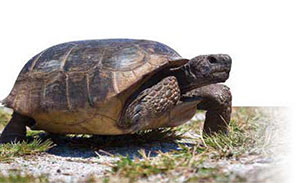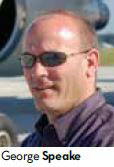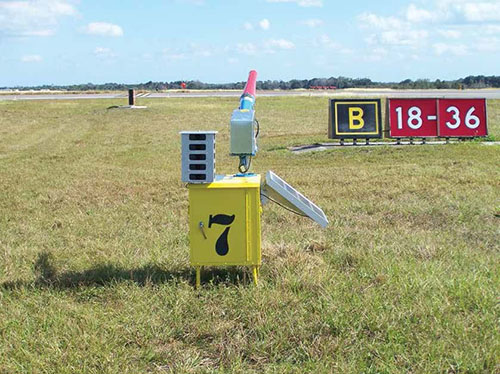Orlando Sanford Int'l & FAA Test Artificial Turf As Tortoise Barrier
 George Speake lightheartedly refers to Orlando Sanford International Airport (SFB) as the "home of gopher tortoise condos." But the long, deep burrows he jokes about are located within the Florida airport's runway safety area; so they actually present a glaring safety problem for SFB's good-natured vice president of operations and maintenance.
George Speake lightheartedly refers to Orlando Sanford International Airport (SFB) as the "home of gopher tortoise condos." But the long, deep burrows he jokes about are located within the Florida airport's runway safety area; so they actually present a glaring safety problem for SFB's good-natured vice president of operations and maintenance.
Because gopher tortoises are a threatened species, the reptiles and their burrows are protected under Florida law. What started as a state issue morphed into a federal matter. The broader regulatory attention,  however, elicited resources and grant money for research. In spring, a one-year study began at SFB to determine whether artificial turf can keep gopher tortoises out.
however, elicited resources and grant money for research. In spring, a one-year study began at SFB to determine whether artificial turf can keep gopher tortoises out.
So far, the results look promising.
How Bad Is It?
 factsfigures factsfiguresProject: Artificial Turf Test Plot Location: Orlando Sanford (FL) Int'l Airport Objective: Determine whether artificial turf prevents gopher tortoises from digging burrows Method: 1-year study of 2 different turfs, installed with & without vegetative growth inhibitor Turf Installation: Feb. 2014 Stakeholders: Sanford Airport Authority, FAA Airport Technology Research & Development Turf Suppliers & Installers: AvTurf; ProGrass Test Area: 153,000 sq. ft. subdivided into 4 different sections Approx. Cost: $580,000 Funding: FAA Other Wildlife Mitigation Methods Used: Cannons, pyrotechnics, lights, sirens, traps, etc. Vendors: Reed-Joseph, Margo Supplies, Atlas Ammo, etc. |
"Go on Google Earth right now and pull up the airport," Speake urges. "If you zoom in on the northwest corner of the airport and around the Runway 18 approach, you can see little white dots all over the place. The white dots are gopher tortoise burrows - lots, and lots, and lots of them."
Realizing the serious safety problems lurking in all those little white dots, Speake turned to the local FAA Airports District Office for help excavating, capturing and relocating the herbivore scavengers that were digging up crucial sections of his airfield. A survey conducted last June by FAA Wildlife Biologist John Weller documented nearly 1,200 burrows within the airport's perimeter fence - some stretching 48 feet long; others reaching nearly 10 feet deep.
"You cannot just dig a hole and put the equipment out there every time you see a burrow and not impact (aircraft) traffic," Speake laments. "On top of that, the tortoises are just going to come back. We excavated over 800 burrows from our safety areas; and by the time we were done, we had 12 back in the areas that we had just cleaned out!"
Ryan King, program manager for FAA Wildlife Hazards Research and Development, explains that the burrows, whether occupied by tortoises or not, are important to the local ecosystem because other species such as snakes and rodents also take refuge within them.
"It makes mitigating a difficult issue, because you have to have multiple permits on various levels just to move and handle gopher tortoises," says King. "You can't just pick them up, take them out, bulldoze the burrows and call it done."
The Tortoise & the Dare
In addition to consulting FAA's Airport Division and Airport District Offices, SFB officials organized a conference with biologists from the U.S. Department of Agriculture and the state and U.S. Fish and Wildlife Services. Consensus among the wildlife specialists was to have the airport serve as a test site for an artificial turf wildlife deterrent. FAA's Airport Technology Research and Development branch was pulled into the mix, and a 3.5-acre area around the approach to SFB's test runway was selected as the test site.
After receiving the general requirements, specifications and construction standards for the project, the airport issued a request for proposals and received three responses. ProGrass and AvTurf earned the contract with a winning bid of approximately $580,000 to provide and install two different weights of turf on a test plot around the perimeter of the runway's blast pad.
AvTurf President Daniel McSwain explains that the test plot includes 22-ounce and 38-ounce turf  products that have been subdivided to contrast the low and high densities of the plastic grass blades.
products that have been subdivided to contrast the low and high densities of the plastic grass blades.
"We are continually trying to find more cost-effective ways for airports to be able to enhance airport safety with the use of artificial turf," McSwain explains. Testing the 22-ounce product next to the 38-ounce product will show that we can reduce costs while still maintaining maximum safety."
In addition, the turfs' sand infill ballast is being tested both with and without a specially formulated vegetative growth inhibitor.
Before the turf was installed, a biologist that specializes in turtles marked existing burrows with flags, and then lowered a camera on a scope into every burrow to see if it was occupied. If a gopher tortoise was found, it was removed and relocated.
"I believe we mapped 120 burrows under the (test site); and of those, nearly 100 were occupied," King reports. "Those tortoises were removed, and then the area was excavated and leveled and prepared for the artificial turf."

The FAA's yearlong process of monitoring the area began in May. Motion-activated cameras that operate day and night take snapshots of wildlife around the artificial turf to help document its performance. Since the artificial turf was installed last February, the FAA has not seen any burrowing activity in the test area, King reports.
"The gopher tortoises will walk on the artificial turf occasionally ... but there is no evidence of any burrowing or attempts to burrow through the artificial turf," he details. "The jury is out, because it is a one-year study; but so far, there have been no indications or evidence of burrowing. So as a barrier to burrowing for gopher tortoises, artificial turf looks promising."
FAA is also studying how vehicles - operations trucks, aircraft rescue and firefighting equipment and even aircraft - perform on the material.
Other Tools in the Arsenal

In addition to testing the artificial turf, personnel from FAA Wildlife Hazards Research and Development also suggested that SFB install an "exclusion barrier" to stop the tortoises from digging onto airport property in the first place. The barrier would essentially be a fence that runs along the perimeter fence of the airport, either above or below ground.
SFB has identified the north end of the airport, where gopher tortoise activity is known to be a higher volume, as the most likely site for the barrier. Although the fencing has yet to be selected and installed, King says it will likely be chain-link or high-tensile plastic.
"The important thing is to make sure that the runway safety area is free of any condition that would make it unsafe for an aircraft," says King. "For that reason, we are attempting to keep gopher tortoises out of the airport entirely. Right now, they are still burrowing on areas of the airport, but their burrowing has been mitigated exactly where the artificial turf is."
But gopher tortoises aren't the only wildlife challenge at SFB. The airport also deals with foxes, coyotes, eagles and other birds. "We have implemented every single device that we have been able to find that we felt was not a waste of money or a further potential hazard," Speake reflects.
As a result, the airport's arsenal includes cannons, pyrotechnics, lights, sirens and traps. "Animals will habituate to anything," he reflects. "So it takes all of that, along with taking animals, in order to have an effective wildlife program."


FREE Whitepaper
PAVIX: Proven Winner for All Airport Concrete Infrastructure
International Chem-Crete Corporation (ICC) manufactures and sells PAVIX, a unique line of crystalline waterproofing products that penetrate into the surface of cured concrete to fill and seal pores and capillary voids, creating a long lasting protective zone within the concrete substrate.
Once concrete is treated, water is prevented from penetrating through this protective zone and causing associated damage, such as freeze-thaw cracking, reinforcing steel corrosion, chloride ion penetration, and ASR related cracking.
This white paper discusses how the PAVIX CCC100 technology works and its applications.








